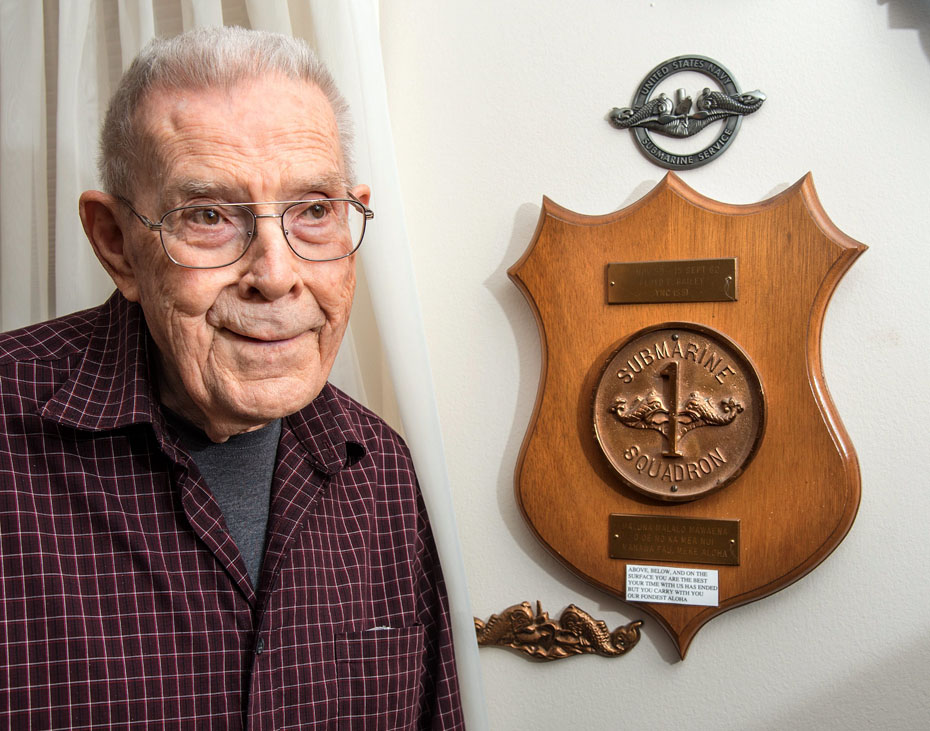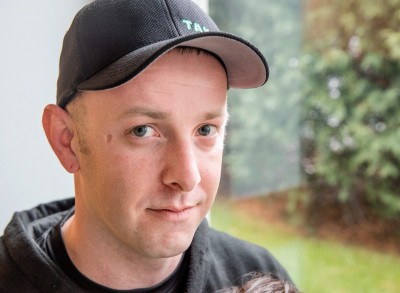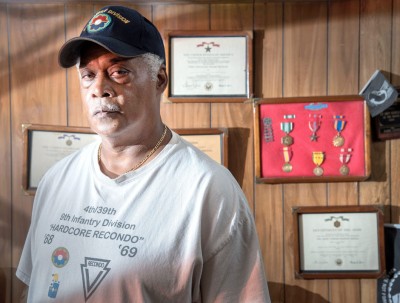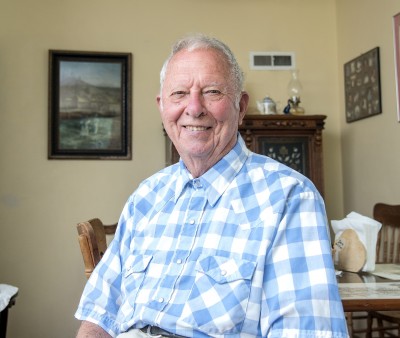Floyd Bailey
By Paul Wood

Photo By Heather Coit/The News-Gazette
URBANA — Floyd Bailey wondered for a couple days if he was crazy — or it was his doctor — before the Navy decided he was stable enough to join the submarine service.
Everybody on the boat volunteers; of the 25 men who volunteered to be in Bailey’s sub class, only two made it.
He had to make it through a week of tests in a psychiatric ward.
Tough crowd.
“I was beginning to think that maybe I was nuts, or maybe the doctor was. In the end, I decided that it wasn’t me,” he says.
He made the grade. The Dolphins, as sub crews call themselves, have a motto.
“In each submarine there are men who, in the hour of emergency or peril at sea, can turn to each other. These men are ultimately responsible to themselves and each other for all aspects of operation of their submarine. They are the crew. They are the ship.”
Bailey, 89, spent 30 years in the Navy in the submarine service, intelligence and recruiting.
“I did just about everything,” says Bailey, who later moved to Urbana to work as an administrator in the University of Illinois NROTC program.
A Wisconsin native, he enlisted in the Navy in 1945, just in time for World War II — to end.
He was in San Diego when the Japanese surrendered. But as a Dolphin, he took on dangerous duty as the boat tried out new techniques, including its first missile systems.
While stationed at sub school in New London, Conn., the sailors took train trips to New York City.
Bailey has a head for numbers, and remembers his pay: $31 a month. But in New York, he could stay at the YMCA for 50 cents a night.
Back in San Diego, his first sub was the USS Chopper.
Because World War II veterans were returning to peacetime lives, the subs were operating with half crews.
“There was never a dull moment,” he says.
He later served on a sub tender, a ship that supplied the boats, before moving on to temporary duty on the USS Pomodon, which set an underwater speed record while “it made us bounce around like a cork.”
As “writer” on the sub, Bailey dealt with records and correspondence.
“That included court-martials,” he says, adding that they were rare on subs — “unless somebody did something pretty bad.”
His service on the USS Carbonero involved the original guided missile program. Each boat had one missile, and at first, he says, they couldn’t be fired from depth.
The testing was at Port Hueneme, Calif., unless seas were too rough. Eventually, it was moved to Pearl Harbor, Hawaii, where Bailey says conditions were better.
At the start of the Korean War, the Carbonero received orders to sail there, but the order was canceled. Shortly thereafter, Bailey was promoted to chief petty officer in San Diego.
His next assignment was in the Office of the Chief of Naval Operations at the Pentagon. He didn’t care for the muggy summers of Washington, D.C.
As an intelligence officer in Turkey, he went to Ankara, where he thought he’d be stationed, but ended up in Istanbul, where code-breaking technology was inferior. All the code machine training was wasted, he says.
But he did take photographs of Russian ships that proved useful to his superiors.
Bailey’s most dangerous moment turned out not to be on a sub.
Making a courier trip to Ankara, he returned on a military flight to Istanbul.
The pilot received take-off clearance, started down the runway, but had to shut down after losing one engine. The next plane was cleared for takeoff.
Over the Sea of Marmara, Bailey was seated in front of the emergency escape hatch.
It came open.
And Bailey nearly fell out of the plane when “the guy next to me pulled me back in.”
After that, he begged out of courier missions.
After his ROTC stint, Bailey retired from the Navy as a chief yeoman.
But he didn’t stop working. He worked at the J.C. Penney store in downtown Champaign (now The News-Gazette building) and later supervised the store room for the UI chemistry department.
He and wife Virginia raised three children.
Do you know a veteran who could share a story about military service? Contact staff writer Paul Wood at pwood@news-gazette.com.
Read more stories from local veterans:
 Dann Hufford
RANTOUL — Staff Sgt. Dann Hufford earned the Bronze Star facing down a truck full of explosives heading right at him. It …
Dann Hufford
RANTOUL — Staff Sgt. Dann Hufford earned the Bronze Star facing down a truck full of explosives heading right at him. It …
 Robin Counce
CHAMPAIGN — Robin Counce, who carried a grenade launcher in Vietnam, was nearly killed by “friendly fire” and still sees …
Robin Counce
CHAMPAIGN — Robin Counce, who carried a grenade launcher in Vietnam, was nearly killed by “friendly fire” and still sees …
 Don Saupe
URBANA — Apparently, silence is golden in the Army. Don Saupe was on a troop ship in the Pacific when the end of World W …
Don Saupe
URBANA — Apparently, silence is golden in the Army. Don Saupe was on a troop ship in the Pacific when the end of World W …